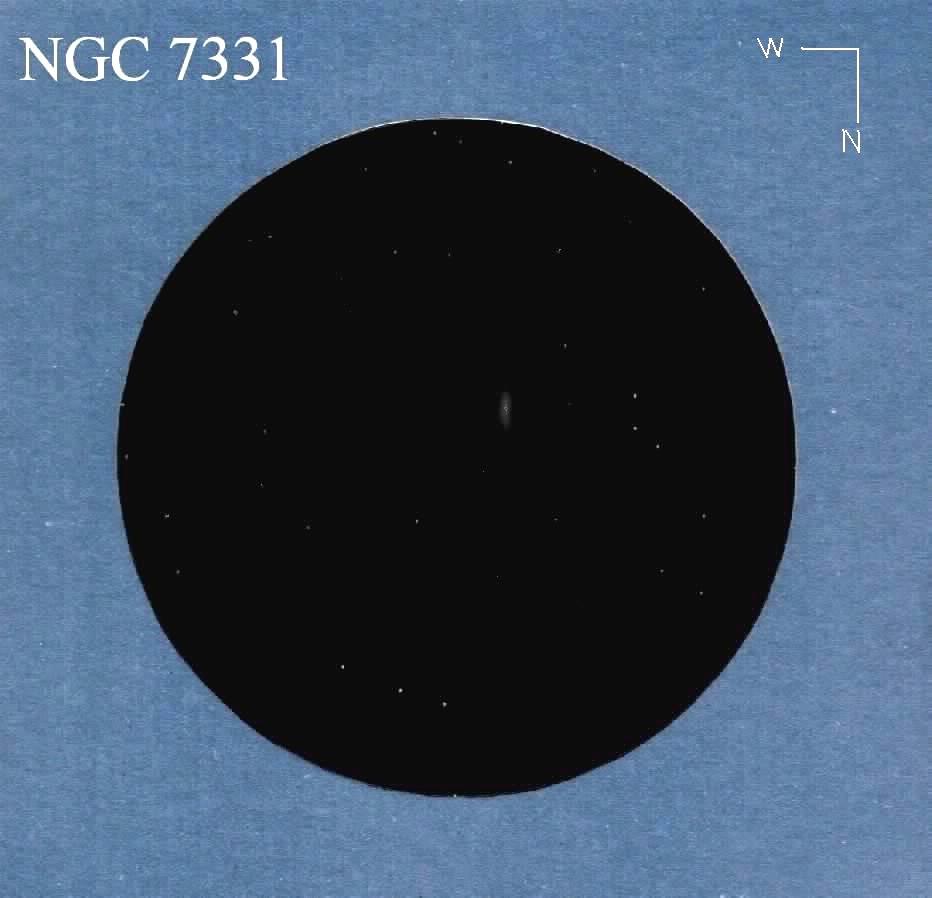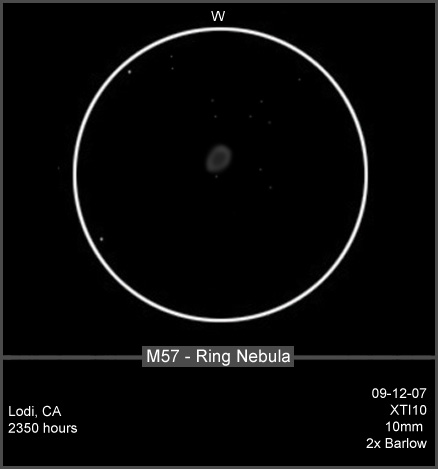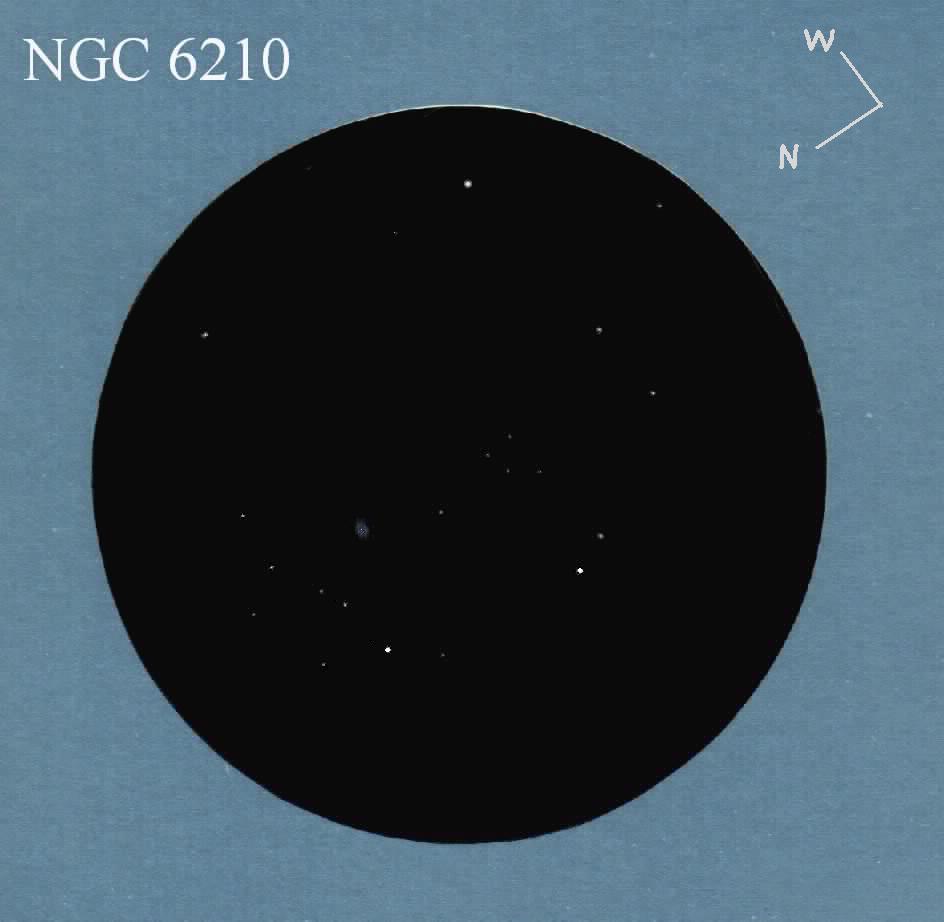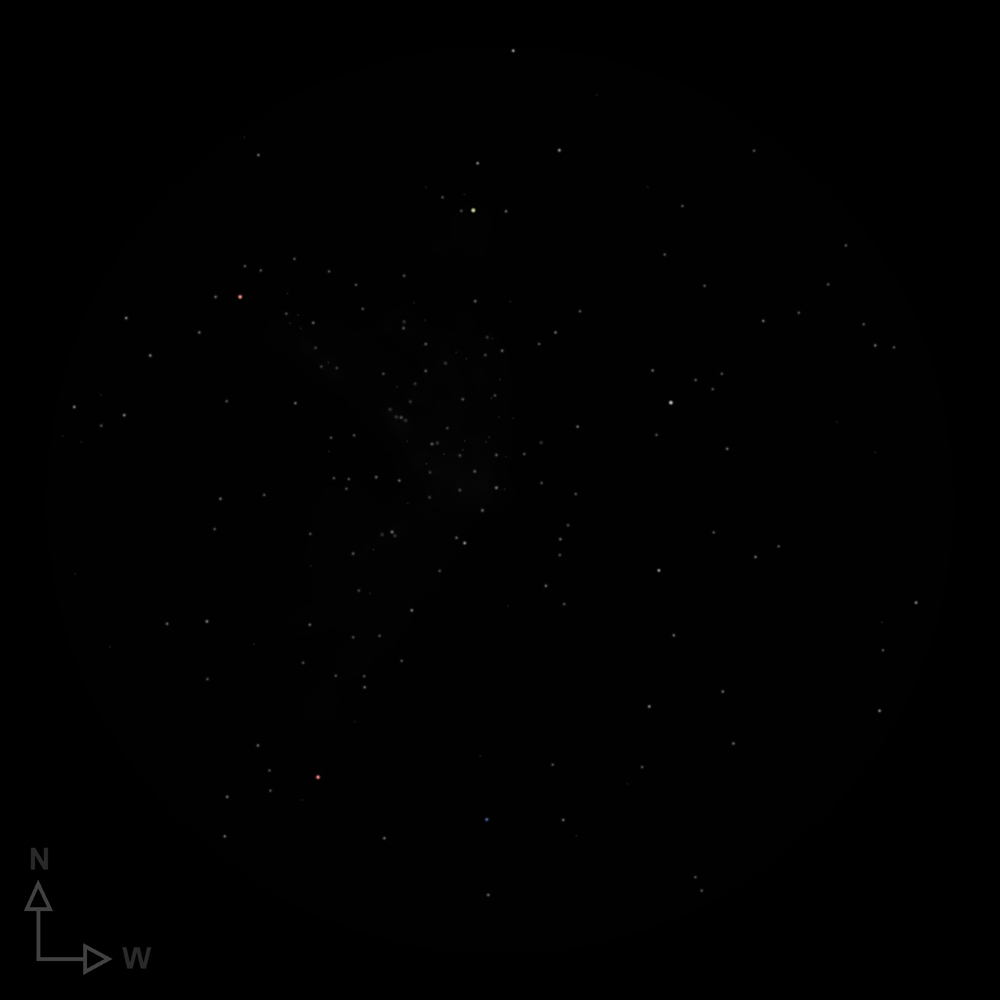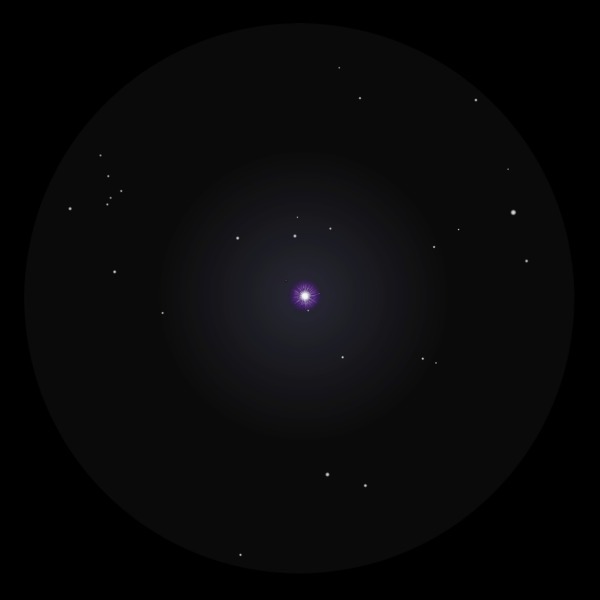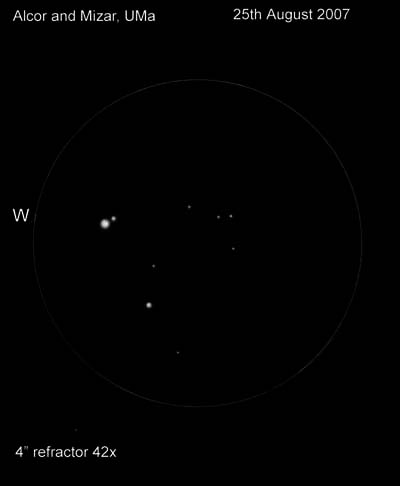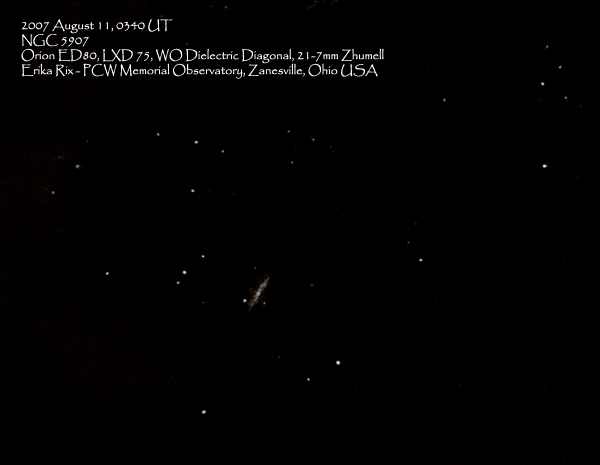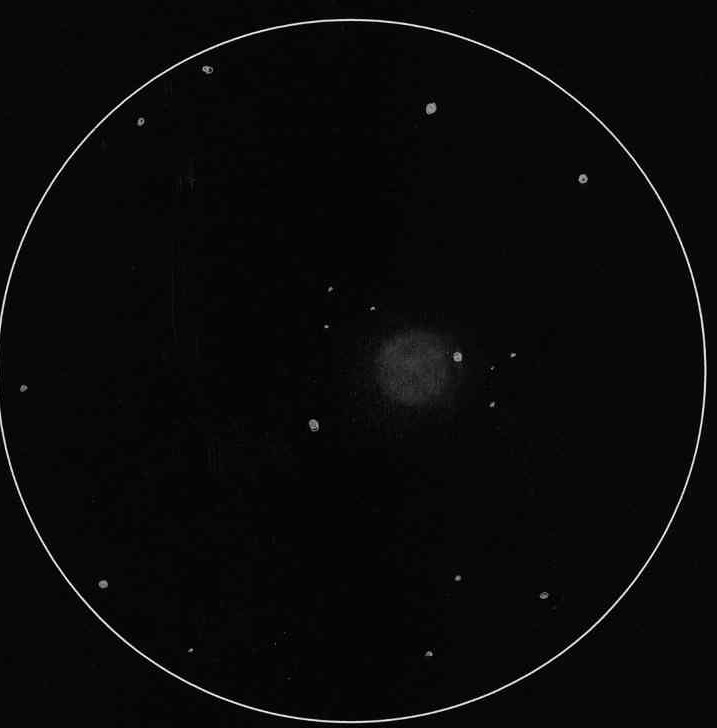With the high pressure dry air mass moving out of Canada into the Midwestern
United States, we had a cool clear night for observing the night sky. I chose for
sketching the brightest galaxy in the constellation of Pegasus NGC 7331. This Sb
galaxy called a nebula by William Herschel in the late 18th century is 10’ x 2’ in
size as seen in the sky. This spiral galaxy is somewhere between 43-49 million
light years away and glows at magnitude 9.7. NGC 7331 has been compared to our
milky way in size, spiral structure and general appearance. There are a number of
other galaxies fainter than 13th magnitude in the same field of view but
undetectable under my urban sky conditions with a 10” scope.
Sketching:
Date and Time: 9-12-2007, 3:20-3:50 UT
Scope: 10” f/5.7 Dobsonian. 21mm and 12mm eyepieces 70x and 121x
8”x12” white sketching paper, B, 2B graphite pencils, scanned and inverted, star
magnitude adjustments using Paint
Seeing: Pickering 8/10
Transparency: above average 4/5
Nelm: 4.9
Frank McCabe
Category: Pencil
Ghost of an ancient Sun
Brightest Planetary in the Strongman
Now that summer is winding down in the northern hemisphere, we are approaching the
time when the constellation Hercules is getting lower in the western sky after
evening twilight. Soon it will be too low for ideal evening observation until next
year. Of the three brightest planetaries in Hercules, the one that wins out is NGC
6210. This little bluish planetary nebula is easily located south of the keystone
and glows at magnitude 8.8. The nebula appears slightly elongated in the east-west
direction and sports a 12.5 magnitude central star. The diameter appears to be
about 13” of arc and with a narrow band filter just a bit larger. This planetary
is estimated to be about 6500 light years away.
Sketching:
Date and Time: 9-12-2007, 2:10-2:40 UT
Scope: 10” f/5.7 Dobsonian. 21mm and 12mm eyepieces 70x and 121x
8”x12” white sketching paper, B, 2B graphite pencils, scanned and inverted, star
magnitude adjustments using Paint
Averted vision was a very useful aid in this sketch.
Seeing: Pickering 8/10
Transparency: above average 4/5
Nelm: 4.9
Frank McCabe
In the court of the King
Object Name: NGC 6939 (H.VI.42)Object Type: Open Cluster
Constellation: Cepheus
Right Ascension (2000.0): 20h 31.4m
Declination (2000.0): +60° 38′
Magnitude: 7.8
Diameter: 8′
Trumpler Type: I 1 m
Telescope: Parks Astrolight EQ6 • 6″ f/6 Newtonian Reflector
Eyepiece: 7.5mm Parks Gold Series Plössl • 120x, 26′ FoV
Date & Time: 8 September 2007 • 03:30 UT
Seeing Conditions: NELM 6.3 • Pickering 8
Observing Location: Cuyamaca Mts., San Diego Co., California
Sketch Information: Digital rendition based on paper and pencil eyepiece sketch.
NGC 6939 is a subtle, yet beautiful open cluster in the southwestern reaches of
Cepheus, near the border with Cygnus. NGC 6939 is famous for sharing a low-power
field of view with the spiral galaxy NGC 6946; this celestial odd-couple has been
the target of countless astrophotographs. The juxtaposition of these two objects is
equally accessible to the visual observer with access to dark skies and a field of
view wide enough to accommodate the 38′ that separate the duo.
The most expeditious way for the star-hopper to locate this object is to center your
scope on 3rd magnitude Eta (η) Cephei and sweep about 1.5° east and just over 1°
south with your lowest-power, widest-field eyepiece. At 30x, I see a fairly
conspicuous patch of nebulosity studded with a few dozen faint stars nestled in a
very rich patch of the Milky Way. The spiral galaxy NGC 6946 glows feebly ½° away
to the southeast.
Zeroing in on this stellar concentration with higher magnifications brings out a
delicate array of faint stars ranging from magnitude 11 down to 14 and beyond. The
soft, often glittering haze of unresolved stars persists in the background even at
high magnifications. The stars seem to be arranged in strands stretching toward the
east like gleaming dewdrops in a broken spider’s web. In that direction (east) it
is very difficult to discern where the cluster ends and the starry expanse of the
Milky Way begins. The western edge of the cluster, in contrast is sharply defined,
particularly on the southwestern side. This sudden drop-off in the stellar
population gives me the impression of an interposing finger of dark nebulosity
thrusting northwestward.
Sir William Herschel discovered NGC 6969 on September 9, 1798 with his 18.7-inch
reflector. This cluster lies at a distance of about 4,000 light-years and is
believed to be 1.8 billion years old based on the Hertzsprung-Russell diagram of its
constituent stars.
Eric Graff
Ice Blue Vega
Here is a simple sketch of the dazzling light from Vega. A mag zero star fills the
field with a radiant glow. It sure ruins my night vision, making it hard and almost
painfull to look for faint companions. It is my impression that 3 little stars
suround Vega. It’s a daunting task to find a sweet spot on my retina for the fainter
stars, while Vega tries to burn a hole in my eye. I could not resist but to hold my
hand against my head to darken the eyepiece as if a streetlight was interfering with
my observation. Useless of course. I also tried to show the secondary spectrum of
the (achromatic) Skywatcher around Vega. I hope it makes sense.
Date : September 4, 2007
Time : 22.00UT
Scope : Skywatcher 102/500
Vixen LV Zoom at 8mm
Power : x63
FOV: 48′
Filter : none
Seeing : 3.5/5
Transp. : 3/5
Nelm : 5.3
Sketch Orientation : N up, W right.
Digital sketch made with PhotoPaint, based on a raw pencil sketch.
Rony De Laet
Twice as beautiful
Alcor and Mizar. Pencil on white paper inverted in Photoshop. This is the first
sketch I’d been able to make, in my first observing session for months (due mainly
to bad weather and constant cloud cover). It was made on August 24th, 2007, using
my 4″ refractor, ideal for double star observations. The conditions were pretty
horrible – milky skies and a waxing, almost full Moon.
Date: 24th August 2007
Instrument: 4″ refractor
Magnification: 42x
Location: My backyard, Isle of Wight, England
Conditions: Horrible! Waxing, almost full Moon, hazy skies. Not much use for
‘proper’ deep sky observing.
NELM: 5.0
Notes; A well-known double. A beautiful sight in the refractor
Faith Jordan
Cosmic needle
2007 August 11, 0340 UT
Erika Rix
PCW Memorial Observatory
Zanesville, Ohio USA
NCG 6503
An Orion ED80 was used on an LXD75 mount, all of which were on antivibration pads in
the observatory. The eyepiece was a Zhumell 21-7mm zoom and a WO dielectric
diagonal.
This sketch was done with Rite in the Rain paper, a number 2 and .3mm as well as
.5mm mechanical pencils
Stan’s Nebula
NGC 7048
I have a very dear friend who inspired this little deep sky sketch and I wish to
share the story with you.
Stan Waterman and I are very close friends but as astronomers we are ‘poles’
apart. Stan a scientist never looks through his telescopes he uses them as lenses
for his mighty camera. His aim is to locate extra solar planets by measuring the
minute dimming of their stellar light. Clear night after clear night he captures
the photons on his chip from 20,000 distant suns in Cygnus and run’s them through
his self written software program to look for dips. He has been doing this for 5
years and has amassed terabytes of data.
I for my sins am a visual observer and a romancer of the heavens stealing my
photons with pencil and pastel.
In other ways Stan and I are much closer, we both love with a passion all of
natures splendours and discuss its wonders over coffee when our busy lives allow.
We enjoy looking at the star patterns on the PC monitor that his camera has
capture in such profusion. A number of times we have wondered together over an
eye catching pretty, round planetary nebula caught in the web of stars.
These shared wondering inspired me to point my own telescope into Cygnus to
located this memorial to a once fine star and capture it with my pencil.
NGC 7048 Details:
Planetary Nebula
Constellation of Cygnus
Mag 12.1 Angular dimensions 1″
RA 2h 14m 33sec DEC +46deg 19m 23sec
Telescope/observation details:
14″ F5 Newtonian, magnification 175X, fov 0′ 17″
Seeing Ant 11, Transparency good
UHC Filter
Chippingdale observatory, Nr Buntingford, UK
Swirling starry majesty
I captured M106 from my astronomy club’s dark sky location at Crowley Nature Center
in northeast Sarasota County, Florida. I was able to detect structure quite easily
under dark, transparent skies, and it made for an enjoyable sketch.
This sketch was rendered on Strathmore Windpower Sketch paper with a General’s Extra
Black Layout pencil. MGI Photosuite III was used for post processing.
Jason Aldridge
North Port, FL
Eighteen years ago
A Total Lunar Eclipse of the Past: August 16, 1989
On this evening as the moon rose it was both cloudy and foggy over Lake Michigan
to the east. It looked as if the weather was going to spoil the show. As
Capricornus carried the moon higher in the sky to the south, conditions improved
and eventually the entire sky cleared as totality began. During the second half of
totality the moon nearly disappeared from view. This was a dark lunar eclipse.
Just after 10 pm local time I made this color pencil sketch on black construction
paper to approximate the 50mm binocular view.
Frank McCabe

